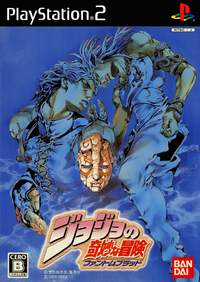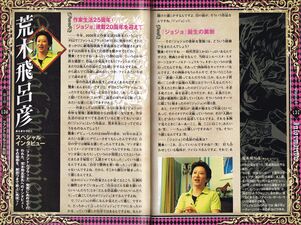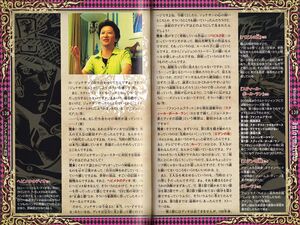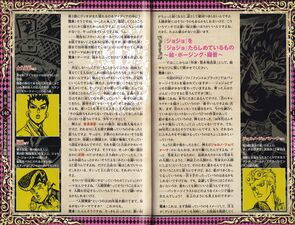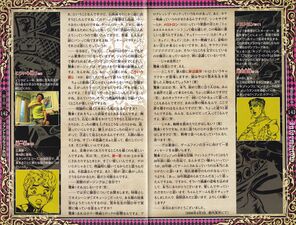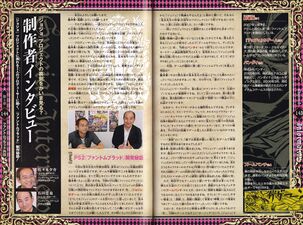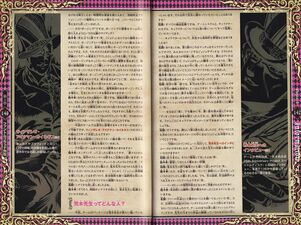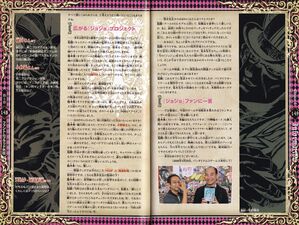Phantom Blood PS2 (October 2006)
Tokai Lecture (June 2006)
Interview Archive
Interviews with Hirohiko Araki, and Bandai Namco staff members Yusuke Sasaki and Chuya Ishida.
The interview with Hirohiko Araki was originally released as part of the pre-order bonus disc for the Phantom Blood PS2 game. The Bandai Namco staff interview was published in the game's guidebook, also included is a condensed version of the video interview with Araki.
Interviews
Interview with Hirohiko Araki
Your thoughts about your 25th anniversary as an author?
I think that it was a very quick 25 years. But when I look back at my work...it's kind of like the stuff around the Phantom Blood era is the work of someone else. Yeah, that's what I honestly feel. So, when I read it I can kind of read it objectively; I can read it as though I was a fan.
Do you read back on your old work?
Not very much, but if there's a game or something released like now, I'll read back and think "Ohh, so I was writing this kind of stuff?" Once the Stands started coming out, I often forget about some characters. Someone will mention a guy and I'll be like, "Who was that again?" and I'll read back and say "Ohh yeah there was that guy." Kind of like that. The readers know more than me.
Next year will be the 20th anniversary of JoJo.
Well, they let me debut on the New Year's of '82 but that still felt a bit vague to me. I couldn't really imagine myself as a manga artist; it wasn't clear on what kind of manga artist I was going to be. It was like I just was incidentally awarded the Tezuka Award, it wasn't really like I was aiming to win it. So that was kind of when I began training. And...when I look at the other Jump artists manga, they all had their own distinct styles. So the period when I was thinking about what style and what kind of manga I should draw was right before JoJo. I sort of feel that I finally became a pro with JoJo; it was like everything opened up in front of my eyes.
How was "JoJo" born?
I liked movies and at the time Sylvester Stallone and Arnold Schwarzenegger were popular. They're both muscular characters and their bodies are covered in muscle, which made me think to myself "I wonder who the strongest person in the world is?" This question was basically the beginning of the idea of JoJo. Themes such as immortality, seeking life, justice and things that humans innately seek spawned from this and eventually lead to the creation of Part one. So basically stuff to do with immortality and super macho guys and how strong they can get; that was what I was pursuing. Also, I had gone on a trip to Italy about 2 years before that and you may already know but, the art in Italy kind of strives for human beauty. When I saw the original artworks, it made me want to do the same.
The origin of the name "JoJo"
I wonder if it's okay to say this..? Umm, the place I used to hold meetings with the editor was at a local family restaurant in my neighborhood called Jonathan's. We were thinking of making the name "Jonathan" Something, and you know how a name can be two S's like Steven Spielberg? I wanted something like that so I thought "Well if it's Jonathan then it'll start with J so...Joestar should be okay." But that was really adventurous for a Shonen manga because it was taboo to have a foreigner as a main character; it was that kind of era. It was a big adventure so I was really grateful to my editor at the time.
Regarding the birth of the arch nemesis, Dio
He's full of confidence, very arrogant and he's aiming to become a God, or top of the world. Because of this, I used the Italian word, 'Dio,' that is used to refer to a God, as well as the 'Dio' that plays Heavy Metal. I like Heavy Metal and Rock so I used those as a reference to make characters. They're also characters that I created to signify 'black and white' or good and evil.'
Part 1:Phantom Blood
What were your initial ideas?
Back when I started drawing part one, I liked stories that went over several generations like 'East of Eden' and the show 'Roots' that they did on TV. The lead character changes but it kinda continues; it's something like an American periodical drama or periodical novel. And I don't think it was very Jump-like in style but I thought that it might be good to go where nobody else had before.
There's also a manga that I really respect called Babel II by Yokoyama Mitsuteru which has fights that follow rules. I also wanted fights that followed rules in JoJo, so the Ripple was one of those things. Also, you can't see psychic abilities right? Like if you concentrate your mind and something breaks, you can't really see it. But it's a manga so I thought I should be able to draw it and try and make it easy for readers to know what kind of psychic powers they were, which is how I came up with the ripple. It kind of spread from that like how ripples slowly spread, no pun intended. (Slowly is 'jojo' in Japanese)
When I look at him now, I think Jonathan is too much of a good boy. If I was to draw him now, I'd probably show more of the weaknesses of his heart too.
Part 2: Battle Tendency
Was Joseph's personality affected by Part one?
One more thing that you weren't supposed to do in those days was to let your main character die. That was another forbidden act. We had a discussion as to whether that will happen first and it was eventually decided in a meeting that we'd kill the main character. Because of this, I had to drastically change the story's characters and portray events that I didn't show in part one in part two and then similarly portray events I didn't show in part two in part three. That was my plan. I had a story devised up until part three, but because the story convention required Part 2 to be different to Part 1, I created Joseph. He does share similarities to Jonathan though in that he is also a muscle type.
Was it always your plan to revive Dio in Part 3?
I really wanted to draw him being dead for awhile and then coming back to life, but if I was to do that I needed something to happen in between (Part 2). Yeah.
Part 3: Stardust Crusaders
How was the process of changing from Ripple to Stands?
I tried portraying the ripple through pictures and I also tried portraying the psychic ability of Stands with pictures too but, how should I say it... I wanted to have punches from here (away from body). I had a meeting for it where I was asked, "What are you going to do next? You can't use the Ripple anymore." But when I said, "Well, a punch comes out of here (referring to the front of the body) and breaks stuff," they'd be confused and wouldn't understand me. So I was like, how should I say this...? Well, there's a thing like a guardian spirit and...it comes out and attacks." That's how I explained what the new ability would be and nobody would understand what I was on about. I told them that I think I could create alot of characters this way; I could make like a green colored punch or a sharp thing spawn and make them fight. Unlike the ripple, I can do lots of variations. That's how I started with Stands, though I originally thought that people who read it at first wouldn't know what's going on. Stands gave me alot of trouble when it came to explaining them, but I really felt that I could keep inventing new characters and ideas this way forever. It was like I dug up a gold mine. No one else thought it was gold, but I was like "Wow, look what I dug up!"
Part 4: Diamond is Unbreakable
What were your ideas from Part 4 and onwards?
Part 3 was a story that had the shape of a role playing game. It's like a board game where you go here and there. There's a book called "Around the World in 80 Days," which I made Part 3's story with that as an influence. If that's the case, then enemies have to be types that come and attack Jotaro themselves, though they might be waiting for them too. So when I was thinking of ideas I thought of people that were willing to wait in their positions for a long time: like people that live in houses and attack when customers arrive, people with personalities like trapdoor spiders. I had a lot of these ideas left over and so I thought that I could probably use all of them within a single town. There were various incidents back then such as a serial killing incident that sent huge shockwaves across Japan. The feeling of your neighbor possibly being a serial killer was the perfect atmosphere, so I used that idea when positioning lots of Stand users around the town. That's basically how Part 4 was born and you can see how it's different from part 3. Making Part 3 different to Part 2, and making Part 4 different to part 3...is the way JoJo was made.
Up until Part 3, the setting was in an imaginary, mythical kind of world but for Part 4 I drew an everyday world so I feel more closeness to Josuke, which is why I like him the most. I found it really fun to write, it was like he became a friend of sorts. Jotaro, however, is someone that you admire, like a hero from a mythical tale. But Josuke seems more like a friend or a senior.
Josuke is supposed to be the child of a lover but...?
Yes, he is. If I could write more of Part 4, I'd like to explore that more specifically. You would probably develop some complicated ways of thinking if you were a child of a lover and Josuke was also meeting his dad for the first time in a while, so I'd like to write more in depth about that. If I had the opportunity to write that, I would really like to. Part 4 isn't really finished yet. If I decided to continue it, I could as much as I want.
Part 5: Vento Aureo
Why did you make the hero Dio's son?
Oh yes right. In Part 5, he's not really a blood relative...well kind of. I find great importance in the upbringing and background of the characters. Stuff like what kind of place they were born, and what their parents were like. If I know that then it makes it easier to understand and write. That's what I do it for, so I find bloodlines very important. It might seem like a bit of a stretch, but that's how Part 5 started. During Part 4, the editor said to me, "Are you able to draw sadness?" But life is a sad thing though isn't it? He asked me if I could draw that, and initially I said that it wasn't really my style but during Part 5, I suddenly felt to urge to draw just that. Like the sadness of being ostracized by society but still having a sense of justice. That was what I tearfully wrote for Vento Aureo.
Part 6: Stone Ocean
You once said that you can't draw women.
Back then, it was an era when it was unthinkable to have a female character taking punches and in JoJo, arms can go flying if you're not careful. I felt that I wasn't able to draw that with female characters and the readers wouldn't be able to keep up. As I grew older, the difference between genders became less important, and I started to feel that I could actually draw a tough female. What I came up with was Stone Ocean, whose takes place in a prison setting.
About the end of Part 6
The last boss in JoJo has to be made incredibly strong. And I already made Dio stop time, so I figured the readers wouldn't be happy unless I thought of something even stronger. That factor had become a bubble-like situation and so I thought what would happen if you sped up time really fast, and ended up going full circle. Your brain goes strange when you think about infinity.
What are your thoughts regarding time?
It's mysterious isn't it? If you think about time, it feels mysterious and possibly the ultimate power if you could control it. My thought process involved coming up with this ultimate power and then thinking up how on earth you'd defeat it. Even while writing JoJo I myself often thought, "Oh...they're going to lose this one, they can't possibly win." But thinking about how it will be done is how I go about making this, so even now I still think about the question from Part 1, "Who is the strongest person in the world." I find that there's a great deal of romance there.
Manga Artist Hirohiko Araki
About drawing old characters.
I really find it hard being asked to draw previous characters. I wonder why that is..? I just get really tired. First, I have to try and draw the essence of my older style and then I have to fuse it with my current style, which made drawing the cover of this game really tiring. Though I did end up drawing it anyways after telling them that I can't draw older characters.
Second, artwork always changes; for example, I said before that muscular characters were really popular in the 80's but that wasn't really the case anymore in the 90's. I think it's strange to keep drawing muscular people if that's the case. So when I started on a new chapter back then I made Giorno Giovanna quite thin to be like a normal sized person. From around the time of Josuke, I decided to change from a mythical kind of person to a more ordinary size. That's the kind of way that artwork changes. Well, that's what I think. Also, I don't know about my art getting better. You could say that I was bad at the beginning though. I don't really try to keep it like my older styles; they're pictures that I've drawn in a classical kind of method, so I don't really mind if it changes.
About the game's cover
Well I first imaged it as having the ripple, but I was requested to have Dio and Jonathan fighting with the stone mask but I basically tried to bring the stone mask to the front more. The stone mask is like the game's emblem or the game's mark, so I put water and ripples over the background to lessen its impact. Usually, the main character is right at the front for package illustrations but I kind of made it the opposite of that.
About the poses.
The poses are influenced from Italian sculptures. I really like the way the bodies are twisted and it makes me want to turn them into a drawing. Also, you might not understand unless you're a person that draws, but the pelvis moves up and down and that's what I find fun. Like doing this... and stuff like if you move your wrist than you move up here. (Hand gestures) It's fun to draw while you theorize about that. Well for example, I'll show you here...If you put weight down on your right leg like this, your left shoulder drops and stuff. Or if you raise this hip, you go like this; it all moves oppositely. If you raise one hip then a shoulder goes down. If you concentrate on it you'll notice it, I found that about the human body very interesting and I really find it fun putting that into a drawing.
Also, it's not related but I actually enjoy drawing skin getting peeled. So I had alot of fun when drawing Koichi turning into a book. Not because it's grotesque but I think it's because I have to theorize what it might be like. It's strange. Also, things like what would happen if you bend a finger this way. You can make it possible by drawing. I think those are the kind of things I like, though I like drawing the poses too.
About the unique 'sound words'.
Oh, right. They're influenced from horror movies and rock music. In progressive rock and horror music, they use synthesizers and an instrument called a mellotron and sometimes I really want the tinkly kind of sound it produces for some scenes. Also stuff like "Chwween" and "Kyun Kyun Kyun!" You know how they often have noises like that in horror moves? I get the feeling of wanting those in my work. So I just write them out using letters and they naturally become the sound words I use, and I'm not really conscious of it.
Is the model of Rohan Kishibe yourself?
Everyone I meet for the first time thinks that I'll be like Rohan, so it's a bit of nuisance. I once thought about just acting like that character but that is something I aspire instead and I'm sorry if I break anyone's dreams, but I'm not really like that. Everyone comes into my house a little bit frightened. Sorry, but I'll use this to change my image now.
Do you lick spiders like Rohan?
Well, I do sometimes try eating some unusual things. If they tell me that it's edible cooking then I'll eat it, but... (Laughs)
Themes Embedded in Araki's Work
The theme of JoJo that continues for 20 years?
To not negate human beings. What I mean by that is is to have positive thinking characters that don't stress about things going wrong. They're not allowed to stress. They believe strongly in what they do. Even if its a bad guy doing bad things, those actions are very important to him and he'll use that to move one step forward. Then in response, the hero comes to defeat that. When they both step out forwards they'll then conflict. That's what I find interesting. I don't think it's interesting as a Shonen manga if the hero feels some sort of empathy for the villain. For example, with the character Yoshikage Kira, he's a serial killer but I think that he had his own proper reasons for doing so, such as the poor environment of his childhood, his relationship with his mother and his father always ignoring him. But if I write that you start to feel sorry for Kira, and so despite being such a horrible villain, when Josuke fights him, I think he'll kind of feel sorry for him. But then Kira says that he's fine being that way and moves one step up. That's what I like. That's the reason why I really like Kira. Although he may have had a bad childhood and turned into a serial killer, I always hope that he tries his best at being one. I can't really say that out loud much though. I'm secretly a fan of his. So living with a positive outlook like that is the theme of JoJo. It's a 'celebration of humanity.' To make humans positive. There may be conflicts because of that but that sort of thing is a theme.
Will that remain to be the theme?
Yes, probably. I said this before but I think that if the villains weak, it'll definitely be a boring story. They may be that way in real life but its better if its not in a manga like this. Yes...so I don't think it'll change.
A final message to the fans
荒木飛呂彦
スペシャルインタビュー
『ファントムブラッド』発売にあわせて行われた、荒木飛呂彦氏へのインタビュー。その模様を、解説つきで紙上に再現ッ!
――今年、2006年は作家生活25周年ということで、PS2で『ファントムブラッド』が10月に発売され、それをきっかけに劇場版映画や原画展などが開催されます。まずは25周年を迎えての感想を聞かせてください。
荒木:そうですね…あっという間の25年、というのが率直な感想で、作品とか見返すともう『ファントムブラッド』あたりは他人の作品のような感じがするんですよね。だから読んでて冷静に読めるというか、ファンみたいな感じで読めます。
――昔の作品を読み返すことはよくあるんですか?
荒木:あんまりないですけど、やはりこういうゲームになったりするときはちょっと見たりすると、「おー、こんなこと描いてたのか」とか(笑)。「読者のほうがよく知ってる」みたいな感じになってますけれど。
――作家としては25周年、さらに来年は『ジョジョの奇妙な冒険』連載開始から20周年になります。作家生活のほぼすべてを占めていると言ってもいいほどの『ジョジョ』という作品は、荒木先生にとってどのようなものなんでしょう?
荒木:デビューしたのは1980年の暮れ、'81年のお正月みたいな感じにデビューさせてもらったんですけど、自分の中では曖昧な感じだったんですよね。マンガ家としてイメージができてないっていうんですかね、「どんなマンガ家になろう」っていうのが漠然としてたというか。たまたま手塚賞で「入選させてもらった」っていう感じなんですよね。「自分で勝利を奪い取った」って感じじゃないんですよね。だから、そこから修行が始まったって感じなんですよ。
ほかのジャンプの作家さんとか見てるとこう、圧倒的に個性とかすごいなぁって。「自分はどんな絵を描いたらいいんだろう」とか「どんな作品描いたらいいんだろう」って過ごしてたのが『ジョジョ』までなんですよね。
で、『ジョジョ』の時になんか見えたって感じ。ですから、どっちかって言ったら『ジョジョ』でプロになったのかな、っていう感じが自分ではあるんですよね。なんか開けた感じがするんですよ、目の前が。そういう作品なんですね、『ジョジョ』って。
――その『ジョジョの奇妙な冒険』は、どういう経緯で生まれたんでしょう?
荒木:そうですね……時代背景とかはいっぱいあるんですけど、映画とか好きなんで、当時はシルベスタ・スタローンとかアーノルド・シュワルツェネガーというのが流行ってたんですね。それって“肉体的なキャラクター”なんですよ。その肉体がもうムキムキで、そういうところから「一番強い人間ってなんだろうな」とか、なんか子供的に「この世で最強の人間とはどういう人なんだろう」と考えたときに始まったのが『ジョジョ』っていう。不老不死だとか、命を追求したりだとか、あと、正義だとか。人間が根源的に追求していくもの、そういうのをテーマに描こうと始まったのが『ジョジョ』の第1部。
あと、イタリア旅行が(連載が始まる)2年前くらいにあって、そのイタリアの美術っていうのが、その"人間の美しさ"みたいなのを追求してるんですよ。それを本物で見たときに「あーあーここ、俺、ここに行こう」みたいな(笑)。……ちょっと難しいですかね? でも、そういう感じなんですよ(笑)。
――「ジョジョ」の名前の由来は?
荒木:…これ、言っていいんですかね?(笑) 打ち合わせしている場所が、ファミレスなんですよ。それで、あの…ジョナサンで打ち合わせしてたんですよ。それで「ジョナサンなんとかにしよう」みたいな感じで(笑)。
あと、スティーブン・スピルバーグとかって"S"と"S"だったりするじゃないですか。ああいう、韻を踏むじゃないけど、ジョナサンだったらGとGでいくから「じゃあジョースターとかにしようかな」みたいな。で、「ジョジョだ!」と(笑)。
――じゃあ、もし打ち合わせの場所が違っていたら……?(笑)
荒木:(笑)。でもね、あれは少年マンガでは冒険で、外人の主人公は絶対タブーだったんですよ。なんかそういう時代だったんですよね。だから、当時の担当さんには本当に感謝しています。普通だったらやめろって言うとこなんですよね。
――そのジョナサン・ジョースターに対抗する宿敵・ディオはどのようにして?
荒木:イタリア語とかに"ディオ"っていう神様みたいなものを示す言葉があって。「自分は神をめざしている」っていう感じですよね。世界の頂点。すごい自信満々で傲慢なんですよね。それと、ヘビメタのディオ(笑)。(※1)[a]ヘビメタ好きなんで。そういうのとかけて、キャラクターを作ってったって感じですかね。"白と黒の対決"とか"正義と悪"とか、そういう象徴的に作ってったキャラクターなんですよね。
だから、ジョナサンは今見ると「本当、いい子すぎるな」みたいなね。ディオは完全に光と影って感じのイメージですよね。今描くとしたら、ジョナサンの心の弱いところとか、そういうところも描いていったんだろうけど。
――波紋のアイディアはどのようにして生まれたんでしょう?
荒木:僕がすごく尊敬している作品に『バビル2世』(※2)[b]っていうマンガがあって、横山光輝先生の作品なんですけど、それっていうのは、ルールの下に闘っていくんですよ。だから『ジョジョ』のストーリー上の闘いもルールが欲しかったんですね。波紋っていうのはそういうものだったんですよ。
でも、超能力って目に見えないじゃないですか。こう、「う〜」って念じるとバーンと割れたりとかって、見えないというか。だけど「マンガなんだから絶対絵にできるはずだ」と思って、読者にとにかくわかりやすいように「どういう超能力なんだろう」というので作ったのが、波紋っていう。波紋が広がるように、こう徐々に広がるように……ダジャレじゃないですけど、そういう感じですね(笑)。
――『ファントムブラッド』から現在連載中の『スティール・ボール・ラン』(※3)[c]まで続く、「ジョースター家とディオの因縁」という構想は、最初からあったのですか?
荒木:そうですね。まず1つは、第1部を描き始めたときっていうのは「先祖からいく」っていう。『エデンの東』(※4)[d]とかね、ああいうのがちょっと好きだったんですよ。あと、テレビでやってた『ルーツ』(※5)[e]とか。主人公が変わるんだけど、なんかこう続いているんですよ。アメリカのそういう大河ドラマみたいなのがあって。で、「現代にとにかく行こう」っていうので、なんかちょっとジャンプ的じゃないなぁとか思ったんですけど、そういう誰も描いてないところをいくのもいいのかな、と。
あと、主人公を死なせるっていうのも、(当時は)1つの禁じ手だったんですけど。まぁ、それを踏まえるかどうかの決断がまずあって。で、第1部で描かれてない部分を第2部でやって、第2部で描かれてない部分を第3部でやるっていうふうに。そういうふうに考えてたんですよね。第3部までは(最初から)あったんです、ストーリーはね。
――第2部にはディオは出てきませんが、100年後、第3部にディオがまた現れるのもアイディアの中に?
荒木:そうですね。いったん死んで、復活してくるところがとにかく描きたかったんですよ。だったらちょっと間がないと、やっぱりまずいんですよね。うん。
――現在も『スティール・ボール・ラン』を連載中なのでお話できないこともあるとは思いますが、第1部から第7部まで20年描き続けている『ジョジョ』のすべてに共通するテーマはありますか?
荒木:テーマは、前から言ってるけど"人間を否定しない"。
否定しないってどういうことかって言うと、前向きに考えてく主人公が「これは駄目なんだろうな」とかって悩まないんですよ。悩んじゃいけないっていうか、肯定的にいくんですよね。例えば、自分が悪いことをしている悪人がいても、そいつは「その悪いことが俺にとっては大切なことなんだ」って一歩前に出てくる。正義の主人公はそれに対して打ち砕くっていう。一歩ずつ前に出てきたら、激突するじゃないですか。そこが面白いんですよね。悪いことを考えてる人を、(主人公のほうが)「その気持ちもわからないでもないなぁ」ってなったら面白くないと思うんですよ、少年マンガとして。
例えば、吉良吉影(※6)[f]の場合、奴は殺人鬼なんですけど、それなりに人を殺す動機っていうのがあったと思うんですよ、やっぱり。子供のときのかわいそうな境遇だとか、母親との関係とか、父親が無視してたっていう設定があるんですけど、それを描くと吉良がかわいそうになってくるんですよ。そうすると、せっかく強い悪役なのに仗助(※7)[g]がそれに立ち向かっていったら、「なんかお前ちょっとかわいそうだよな」みたいな闘いになると思うんですよね。だけど吉良は「俺はこれでいいんだ」みたいな、ガンって上に出てくる。それがいいんですよ。
そういう"肯定的にやる"っていうのが『ジョジョ』のテーマなんですよね。"人間賛歌"ってそういうことなんです。人間を肯定するっていうんですか。そこで闘いがあるかもしれないけど。
――"人間賛歌"というのは20年描き続けてきて、揺るがないテーマですか? これからも。
荒木:たぶんそうですね。さっきも言ったけど、悪い奴がちょっと弱くなると、話として絶対つまらないんですよ。人間世界にはそういうのもあるかもしれないけど。こういうマンガでは悪い奴は強いほうがいいんですよね。だから、たぶん揺るがないと思います。
――ではここからは「作家・荒木飛呂彦」として、絵やセリフに関して聞かせてください。
荒木:はい。
――今回のPS2ソフト『ファントムブラッド』ではパッケージイラストを描かれていますが……ジョジョとディオの顔がかなり変わっていますよね。買った人はたぶんビックリすると思うんですが(笑)。
荒木:これね、本当にたまにあるんですけど、「昔のキャラクターを描け」っていうのが一番辛いんですよね(苦笑)。まず、昔のエッセンスを描きながら、今のを融合していかないといけないっていう2つの作業があって。絵が変わるっていうのは、例えばさっき、「80年代はムキムキが流行ってた」って言ったじゃないですか。でも、90年代になるとそうでもないんですよ、もう。それなのにムキムキをやり続けるっていうのはちょっとおかしいっていうか。
ちょうど部が変わったときに、例えばジョルノ・ジョバァーナ(※8)[h]なんかは、かなり細くしたんですよね、グっと。等身大にするために。仗助あたりからもう等身大の人間にしようと。「神話上の人間から、等身大の人間にしよう」ということで、そのときに変わるんですよね。そういうことだと思うんですけど。あと、絵がうまくなってるっていうのも…昔下手だったっていうのはあるかもしれないですけどね。でも、意識して昔のにはこだわらないというか、変わっても別にいいと思うんですけど。
――パッケージイラストはどのようなイメージで描かれたんでしょう? 水上のようにも見えるのですが……?
荒木:これは、まず波紋っていうのをイメージして。注文が「ディオとジョナサンを対峙して、石仮面を配置してくれ」ということなんですけど。石仮面をとにかく前に出そうとしたんですね。このゲームの象徴は石仮面。マークみたいなものですね、ゲームのマーク。だから、後ろに抑えるためにちょっと水っていうか「波紋の中に入れよう」っていうので描いたんですけど。普通、主人公が前にバンって出てきますよね、パッケージイラストって。それとは逆にしたっていうか。
――なるほど。では次に、これはPS2のゲームでもゲーム要素の1つになっていますが、ジョジョの特徴として挙げられる「ポージング」について聞かせてください。
荒木:ポージングは、やはりイタリア彫刻の影響なんですよ。なんかね、こう、ねじってる感じがね…こういう感じ(※9)[i]。絵にしたいなぁって思うんですよね。
ちょっと絵描く人じゃないとわからないけど、骨盤がね、上がったり下がったりするんですよ。それが楽しいんですよ。「手首をこうやったときにこっちが上がる」とかね。なんていうか、そういう理論的な感じで描いていくところが楽しいんですよね。
――理論的に描くとああいう風になるんですか?
荒木:それをちょっと誇張するとああなるんですよ。例えばこう、右足に体重をかけてこうやると左肩がさがったりとか、こっちの腰を上げるとこうなったりとかね。逆、逆っていくんですよ。腰上がるとこっちの肩がぐっと下がって。注意して見るとわかるんですけど、人間の体のそこがね、すごい不思議だなぁと思って。絵にしていくとき、そこが楽しいんですよね。
あと、皮膚がめくれたりするところを描くのも楽しいんですよね、実は(笑)。だから、康一君(※10)[j]とかが本にされたりするときとか、すごい楽しいんですよ。グロいとかじゃなくて、理論的に描いてるからだと思うんだよね。不思議なんですよ。あと、(指が)逆に曲がったらどうなるのかなとか。絵だと可能なんですよ。
――実際のポージングはご自分で?
荒木:それはしないです(笑)。
――では次に擬音についてお聞きします。特徴としてキスシーンが「ズキューン」だったり、ある種の効果音のようだったりするのは、荒木先生の頭の中で実際に鳴っている音なんですか?
荒木:あれはホラー映画とロックの影響なんですよ。プログレッシブ・ロックっていうものがあって、あと、ホラー映画っていうのがまたあるんですけど。シンセサイザーとか、メロトロン(※11)[k]っていう楽器の音とか。「トゥルルルルルルル~ン♪」って鳴る感じが、この場面に欲しいと思うんですよね。「チュイーーーーン」とか「キュイン、キュイン、キュイン」とか。ホラー映画でよく、意味のない音とか来るじゃないですか。あと、サラウンドの「ゴゴゴゴゴゴ」とか。そういうところを文字にしているのが擬音になっているので、別に意識していないです。
――じゃあ自然と?
荒木:自然とです、ええ。
――ところで、第4部に岸辺露伴(※12)[l]というキャラクターが登場しますが、彼はやはり荒木先生を投影した人物なんでしょうか?(笑)
荒木:ははは(笑)。本当、初めて僕に会う人はね、みんな露伴だと思って来るからね。ちょっと困るんですけど(笑)。あのキャラクターで一回いこうかなぁって思ったこともあるんですけど、あれは僕の憧れなんで。ここで夢を壊すのはなんなんですけど(笑)、ちょっと違うと思うんですよね。みんな、なんかビビって入ってくるんですよ、家に(笑)。
――じゃあ、蜘蛛を舐めたりとかはしない?(笑)
荒木:そうですね、たまに違うものとかは食べてみたりはしますけど(笑)。料理で食べられるっていうんなら、食べます(笑)。
――では最後に、ゲームファンの方々に向けて一言メッセージをお願いします。
荒木:『ジョジョの奇妙な冒険 ファントムブラッド』はもう20年前に描いた作品で、なんかすごい懐かしいっていうか、20年経ってゲームにされるっていうのは本当にありがたいと思います。現在連載中のものがなるっていうよりも、「あっ、20年間認められてたんだな」って思ったんですよね。ですから、そういう感謝の意味を込めまして、本当にありがとうございます。楽しんでやっていただきたいと思います。ちゃんとゲームも色々チェックもしましたんで、保障済みだと思います。よろしくお願いします!
――本日はありがとうございました。
(2006年8月3日、都内某所にて)
Interview with Yusuke Sasaki and Chuya Ishida
{{Tabber |Translation|
A glimpse at the behind-the-scenes of the JoJo project?
Producer Interview
We ask two of the producers involved in the JoJo project about the story behind the Phantom Blood PlayStation 2 game's production!
Yusuke Sasaki
Bandai Namco Games Producer
Chuya Ishida
Bandai Namco Games Media Strategist
Thank you for joining us today.
Sasaki/Ishida: Thank you for having us.
To begin with, can you tell us about your positions and your roles in the JoJo project?
Sasaki: I am the game producer for the upcoming PlayStation 2 game JoJo's Bizarre Adventure: Phantom Blood.
And what exactly does a producer do?
Sasaki: Planning through production management, promoting the game, and other smaller duties... Basically, I do everything (laughs). There are two companies[m] involved in the game's development this time, so I also coordinate their schedules. And of course, I get Araki's approval for everything we work on (regarding this game).
I see. And what about Mr. Ishida? You work as a "media strategist"...?
Ishida: My real job is borrowing the rights to make JoJo products. From there, I lay the groundwork to be able to sell the product, including making the arrangements to begin actually creating it. For this JoJo product, I've been tying it to the film adaptation and pushing it as Bandai merchandise. I'm also in charge of promoting the project as a whole.
Sasaki: I produce the game itself, and Ishida makes sure the entire JoJo project is a success.
This year marks Araki's 25th anniversary as an artist, and next year will be JoJo's 20th birthday. These are enormous milestones. Were all of the various projects, game and animated film included, started at the same time?
Sasaki: Not quite. Regarding the PS2 adaptation of Phantom Blood, I'm a big fan of Araki myself, and a huge fan of JoJo's Bizarre Adventure (laughs). Another company had been in charge of producing JoJo games for a while,[n] but I really wanted the opportunity to work on a JoJo game myself. I was obviously aware that it was Araki's 25th anniversary, so I was given the opportunity to speak with Shueisha, and I asked them to develop a game. That was when I first heard from Ishida that they were making a JoJo movie. So I asked Ishida if we could work on it as a project celebrating Araki's 25th anniversary.
So the two weren't developed as a single project from the start.
Ishida: It was after I found out that talks about the movie were underway. Both Sasaki and I liked JoJo, so we were both like, "Let's make a game, and other merchandise too!" (laughs). At the time, I was in charge of making such arrangements at Bandai,[o] but all three of us (including the person responsible for the card game), went to Shueisha and said, "We want to make JoJo's Bizarre Adventure!" And they said, "Then let's do it."
Why did you choose Part 1: Phantom Blood as the subject matter for this game?
Sasaki: First of all, I really wanted to be involved with Araki's work (laughs). And among that work, Phantom Blood is the best. Within the JoJo series, Part 1 is "Romantic horror." The masses of zombies are almost symbolic. And as you know, the stories of Part 1 and Part 2 are based around the concept of the Ripple, which is different from the Stands in Part 3 onward.
Also, all the characters are unique, starting with Dio, then Speedwagon, Zeppeli, Tarkus and Bruford... There are so many great characters crammed into it. Moreover, even though JoJo itself has been running for 20 years or so, there are a lot of famous lines that I still remember. I thought if we made a game out of all of these elements, like the strong characters and Romantic horror, using modern PS2 technology, it would make for a very good game.
Did you have any trouble expressing the Ripple, an ability difficult to express in pictures, in a video game?
Sasaki: I was really worried at first. There are a lot of action games, but I don't think it's a good idea to just throw JoJo characters into an existing action game. I kept thinking about how to make something that only JoJo could be. To tell the truth, I spent two years or so creating the character models, and all the while, the content of the game changed dozens of times. I kept thinking and thinking about what to do with the Ripple (laughs).
On the other hand, there are also many parts of the original work that are easy to adapt into a game. For example, there are scenes where a great many zombies appear, and even in the case of the Ripple, there's Jonathan's Zoom Punch. There's also the question of what would happen if Ripple was sent into the ground. I think we've successfully combined those easy-to-adapt things with the Ripple, and breathing, which is the important part of the Ripple, in this game. But if that was all there was, it would end up just being a lot of special attacks (laughs). In this game, we incorporated a distinctive element unique to JoJo called "posing," which landed it in a unique genre I call "Overdrive Action."
Whose idea was it to incorporate the element of posing into the game?
Sasaki: Truthfully, it was me (laughs). I wanted to somehow incorporate the unique system of posing in JoJo into the game. At first, it was just the poses. But that wasn't very interesting, so I added the gameplay element of performance evaluation, and it suddenly felt right, somehow. The poses took a lot of research and adjustment. In the early stages of development, they were set up so that difficult commands had to be entered to do them, which turned out to be too stressful. Also, for example, if you strike a cool pose, the screen freezes for a second, as if time is stopped (laughs). We took that into consideration when deciding how to present it visually.
When you perform a pose, sometimes you enter the pose within the normal view, and sometimes there's a big cut-in...?
Sasaki: That's part of the effect too, of course. When the player successfully pulls off a combo attack, we want to show it in a way that matches it. The idea for the close-ups came from the development company that was creating the game. But at first, the shots were all close-ups. Of course, how's the game supposed to work if they're all close-ups (laughs)? We asked the development team to find a good balance in that area.
Almost every character in the original work is playable in this game, but how were the visuals for the new characters (Winzaleo, Eijkman, and Caineghis)[p] created?
Sasaki: We drew the concept art first, and then Araki looked at it and made some changes.
Are there any other original elements in the game?
Sasaki: It's weird to call it the ending, but the very last part. I'm sure everyone knows how the original story goes, but if we made it exactly the same thing, the final boss would necessarily be a one-trick pony (laughs). I was worried about that and thought it wouldn't work, and Araki also gave us some ideas... Anyway, we didn't want to destroy JoJo's original worldview, so after many twists and turns, we arrived at its final form. It's a slightly original development.
Ishida: We had to resubmit the scenario, didn't we?
Sasaki: That's right. We submitted the scenario several times under Araki's supervision.
Araki drew a new illustration for this game's packaging. Has he been involved with anything else?
Ishida: He supervised the entire product, from the game system to the character models. He supervised every single character.
Did Araki have any specific requests regarding the characters?
Ishida: He did, in fact. In Part 1, there were more muscular characters, but he thought that the image that most people have of JoJo and Dio was more likely to be Part 3's. For example, Dio is flashy, while JoJo is a bit thinner. He told us to "prioritize the image that people have in mind, rather than Part 1 of the original work."
Sasaki: For example, in the Phantom Blood game, Dio's costume is actually closer to the image of him from Part 3.
Ishida: In Part 1 of the manga, he's actually more of a handsome young man, a modest British young man. But as you can see in the CG models for the game, he's portrayed as more of a "flashy king of darkness." Also, we paid close attention to details like the curves of his waist when he poses, the flexibility of his wrists, and the tension applied to his toes (laughs).
I see (laughs). But it's definitely true that, when re-reading Part 1, it's surprising to see that Dio wore rather modest clothes. I suppose each and every fan has their own image of the character.
Ishida: That's right. I mentioned Part 3 as an example, but that's what he meant when he said to "prioritize the JoJo that people have in mind."
Just before this interview, we also had an interview with Araki himself, but could you tell us about your impressions of him?
Ishida: Mr. Sasaki, you were really nervous, weren't you (laughs)?
Sasaki:I was so nervous, I could barely speak.
Ishida:You had to speak to Araki through his editor (laughs).
SasakiBut as I listened to him talk, I really felt that he was a wonderful person. But to tell the truth, I was imagining someone like Rohan Kishibe at first (laughs).
Who prepared the interview questions?
Sasaki: Basically, I just put down what I wanted to ask him.
Ishida: I was asking what I wanted to ask as a representative for the fans (laughs). Since Bandai Namco Games has given us the opportunity to create a commemorative DVD for his 25th anniversary, the game's topic would be Part 1: Phantom Blood, but I also felt as I was listening to him that it would be wonderful if I could immortalize all of his work up to the present day on DVD.
How are the game and the theatrical animation scheduled for release next year related?
Ishida: We consulted the movie's director and sound director when deciding on the cast. Some of the cast overlaps with the movie's cast, and others are voice actors attempting to match the movie's characters.
Sasaki: We had both the game and the movie from "the start," but since the movie releases next year, determining the cast was a major hurdle from the beginning. So we double-checked with the movie's director and then decided on the cast for the game. My personal favorite is Mr. Midorikawa's[q] Dio. It's a great role for him.
Will Mr. Midorikawa be playing Dio in the film as well?
Ishida: Yes, Midorikawa has been cast as Dio in the movie.
I heard Midorikawa was so passionate about his voice that he even offered to do retakes during dubbing for the game.
Sasaki: That's correct (laughs). It really is difficult. Dio's character before he puts on the Stone Mask is ever-so-slightly different from his character after he puts on the mask and becomes a vampire. That's why we had to do multiple retakes.
Were there any other cast members who made a particularly strong impression on you?
Sasaki: For me, it would be Speedwagon, played by Masaya Onosaka[s]
Video
Gallery
References
Notes
- ↑ ヘビメタのディオ※1
ロニー・ジェイムス・ディオ率いるロックバンドで、ヘヴィメタルの大御所。バンドのデビューは1983年だが、ロニー自身はディオ結成以前からいくつものバンドに所属していたことがあり、音楽歴はかなり長い。 - ↑ 『バビル2世』※2
横山光輝原作のマンガ。"バビル2世"こと浩一少年が、世界征服をたくらむ超能力者・ヨミと戦う物語。浩一少年もヨミと同じく超能力者であり、荒木先生の言う「ルールの下で戦う」とは、その「超能力者同士の戦い」における設定・描写のことを指している。 - ↑ 『スティール・ボール・ラン』※3
2005年よりウルトラジャンプにて連載中のシリーズ第7部。なお、第1部から第7部までのサブタイトルは以下のとおり。
第1部:ファントムブラッド
第2部:戦闘潮流
第3部:スターダスト・クルセイダース
第4部:ダイヤモンドは砕けない
第5部:黄金の風
第6部:ストーンオーシャン
第7部:スティール・ボール・ラン
サブタイトルは第6部スタート時に初めてつけられ、その際に過去のシリーズにもサブタイトルがつけられた。 - ↑ 『エデンの東』※4
アメリカの小説家・スタインベックの長編小説。1955年にジェームズ・ディーン主演で映画化された。 - ↑ 『ルーツ』※5
アレックス・ヘイリー原作の小説『ルーツ』をTVドラマ化したもの。アメリカ、1977年制作。原作小説は作者自身の家族の来歴を書き記したものである。 - ↑ 吉良吉影※6
第4部「ダイヤモンドは砕けない」に登場。物語の舞台である杜王町で起こっている連続殺人の犯人であり、スタンド「キラークイーン」の能力者。 - ↑ 仗助※7
東方仗助。第4部の主人公。第2部「戦闘潮流」の主人公、ジョセフ・ジョースターの隠し子。髪型をバカにされるとキレる。スタンドは「クレイジーダイヤモンド」。 - ↑ ジョルノ・ジョバァーナ※8
第5部「黄金の風」の主人公。ディオの息子で、本名は「汐華初流乃」。物質に生命を与えることができるスタンド、「ゴールド・エクスペリエンス」の能力者。 - ↑ こういう感じ※9
インタビュー中、実際に荒木先生が自ら身ぶり手ぶりをまじえながら説明してくれた。 - ↑ 康一君※10
広瀬康一。第4部に登場。スタンド「エコーズ」は成長型で、成長するごとに新たな能力を身につけていった。 - ↑ メロトロン※11
テープを音源としたキーボード。鍵盤を押すことによって、音階で録音されているテープ音源を再生する。この原理をデジタルで再現したものが現在のサンプラーである。ジェネシス、キング・クリムゾンなど、「プログレッシブ・ロック」と呼ばれるジャンルに属するロックバンドがよく使っていた。 - ↑ 岸辺露伴※12
第4部に登場。杜王町に在住するマンガ家で、週刊少年ジャンプに『ピンクダークの少年』というマンガを連載している。スタンドは「ヘブンズ・ドアー」。 - ↑ The Phantom Blood PS2 game was published by Bandai Namco Games and developed by Anchor Inc. The latter company was founded in 1996 with a focus on professional wrestling titles, and Phantom Blood would be their final video game project before transitioning to other industries such as renewable energy.
- ↑ Capcom had previously released games based on Part 3: Stardust Crusaders and Part 5: Vento Aureo.
- ↑ In September 2005, Bandai Co., Ltd. merged with Namco Ltd. to establish Bandai Namco Holdings Inc. In March 2006, the game divisions of both companies were merged to form Bandai Namco Games.
- ↑ Like Tarkus and Bruford, Winzaleo, Eijkman, and Caineghis overcame the trial of the 77 Rings. In the original work, they are only mentioned by name.
- ↑ Hikaru Midorikawa belongs to Aoni Production. His other roles include Heero Yuy in Mobile Suit Gundam Wing and Kaede Rukawa in Slam Dunk.
- ↑ "HGIF" (High Grade Imagination Figure) and "Super Modeling Soul" (超造形魂, Chōzokei Tamashī) figures are separate merchandise lines created by Bandai subsidiary Tamashii Nations. The former line commonly produces 1/9 scale figures, while the latter prioritizes a common figure height of around 5 cm (2.0 in).
- ↑ Masaya Onosaka belongs to Aoni Production. His other roles include Momoshiro Takeshi in The Prince of Tennis and Mantaro Muscle in Kinnikuman II. I gave it a lot of thought, but I figured Speedwagon's voice having a bright tone to it would be best. When Mr. Onozaka did it, it turned out to be more hilarious than cool (laughs).
From the drawings, I imagined Speedwagon with a lower voice...
Ishida: It's been a while since the series first released, and everyone's images of the character have developed individually, so it must be difficult to find a voice that everyone can agree on.
Sasaki: Yes, very difficult.
As for other merchandise, so far "HGIF" and "Super Modeling Soul" figures[r] have been released. Were these also supervised by Araki?
Sasaki: Yes. We showed him the prototypes made by the sculptors, and he checked various aspects at that stage.
Ishida: At the time, both Sasaki and I were still at Bandai, and we were supervising them together. He checked things like the curves of his hands, the curves of his waist, his gaze (laughs). By the way, these are technically Bandai products, so maybe it's not a good idea to say too much about them as Bandai Namco Games employees... Anyway, I was in charge of those at the time (laughs).
What other requests did Araki make?
Ishida: He asked that the accessories be extravagant, just like the CG models in the game. Also, the figures we brought in at first were muscular, but he gave us the instruction to "make them a bit more stylish, because I think the image in everyone's minds is a bit slimmer."
I see. That's some rather unusual advice.
Ishida: Right? Most of the time, the original author only asks that we "faithfully reproduce the original," but Araki did something unique and said, "Let's reproduce what the people who like JoJo right now have in mind." Maybe that's what makes his characters different from the other ones we've worked on.
Aside from the games, the movie, and the merchandise that's already on sale, are there any other projects in the works?
IshidaAs we've already announced, Bandai's currently working on a card game. We can't go into too much detail yet, but it'll be a fully-fledged card game with cards featuring Araki's original artwork.
A word to the JoJo fans. Finally, please say a few words to the fans and players who will be buying the game and strategy guide.
Sasaki: I love the main story, of course, but I also have a soft spot for the 77 Rings Knights mode. You can control characters like Tarkus, Bruford, Jack... Characters who make you think, "Wait, I can use this guy too?" I hope people will continue to play it for a long time.
Ishida: The story we were obsessed with as boys has become a video game, and from now on there will be a lot of merchandise, and it'll also be made into a movie. I hope that it won't just be fans from our generation who enjoy it, but the young boys of today as well. It's definitely fun, so please give it a try!
Thank you for your time today.
(Interviewed September 20, 2006, at Bandai Namco Games Headquarters.)
